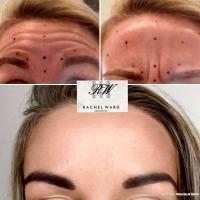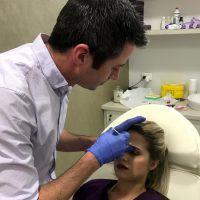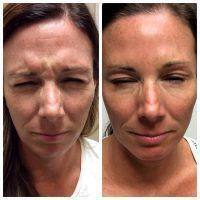Botox Injection Dose
Botox – Amount needed?
Successful injection technique requires a thorough understanding of the facial anatomy and interactions between the muscles.
Patients 30-50 years of age may be most responsive to Botox, because their rhytides are more likely to be caused by muscle activity than by the loss of skin elasticity that occurs during advanced aging.
When making the decision of which product to use, physicians have to consider factors such as therapeutic efficacy, patient satisfaction, safety, and price. Treatment should be initiated at the lowest recommended dose. This dose can be gradually increased in subsequent treatments to the maximum recommended dose, if needed.
The exact dosage and number of injection sites should be tailored to the patient’s needs based on the size, number and location of muscles involved, presence of local muscle weakness, response to previous treatment, and the patient’s medical condition.

Botox Injection Dose For Forehead
The number of units to be injected depends on the specific region and the characteristics of the involved muscles, including their masses. Generally, the muscles of men are greater in mass and require higher doses of botulinum toxin type A.
The required dose and the sites to be injected are also based on an assessment of how the muscles behave in repose, in normal animation, and during maximal contraction. Skin thickness and texture may also contribute to dosing decisions.
Although injections are generally intramuscular, the thickness of the dermis may influence the injection technique.
For example, the skin of Asians tends to be thicker and have more collagen fiber than the skin of Caucasians.
In general, thicker skin requires a higher dose of botulinum toxin type A than thinner skin does for an equivalent outcome. The amount will also depend on muscle bulk. In general, the frown lines require 12-24 units, forehead lines require 10-20 units, and crow’s feet require 5-15 units per side.

Botox Is Just Extremely Diluted Botulism Toxin
These are advanced techniques so be sure to get an experienced cosmetic dermatologist consultation for recommendations and treatment options. (Alim R. Devani, MD, FRCPC, Calgary Dermatologist)
Botox is an individualized treatment and not one size fits all. This sounds like you might be deciding on a daily deal site whether to buy 20 units or 40 units, I would highly advise against that and recommend you follow up with your board certified Dermatologist for proper evaluation and management. (Matthew Elias, DO, FAAD, Fort Lauderdale Dermatologic Surgeon)
The right units of Botox for you
Every patient is different. That’s why I have each patient come in for a full consultation where I ask questions about their medical past, do a examination, and take photographs while the patient changes their facial expressions.

How Many Units Of Botox Did You Get
Then we talk about their aesthetic goals: target areas and degree of effect. All of that put together determines the number of units, which I record in their chart along with the exact location of each unit.
I like to see every patient after their injection to see how they responded. Then I tailor the dosing up or down to meet their goal outcome. Although injections for wrinkles is the most commonly performed office procedure, it is still a complex procedure.
Putting unique patients in a package deal limits the result. I believe you deserve the dedicated time and effort of a trained professional to maximize your outcome. (Victor Chung, MD, San Diego Facial Plastic Surgeon)
Botox – how much to buy?
It depends entirely on what you want treated -Rather than buying a package, have the doctor examine you and tell you how much Botox is needed -And then have that much done. (Elizabeth Morgan, MD, PhD, Atlanta Plastic Surgeon)
Botox is very individualized and the number of units depends on what you need. 40 is twice as much as 20. It seems a good doctor should be able to advise how many units you need for best results and not be selling you a package.
Sometimes I use 10 units, or 16, or 52, and sometimes 20 or 40. It depends on the patient everyone is different. . (Rebecca Baxt, MD, Paramus Dermatologic Surgeon)
There is a great variety of dosing in Botox administration depending on the number of areas treated, severity of wrinkles, muscle bulk, patient metabolism, etc. In general you can anticipate needing anywhere from 15-20 units per area needing treatment. (Nelson Castillo, MD, Atlanta Plastic Surgeon)
Botox: 20 or 40 Units?
It’s best to understand first what your goals are for your treatment with Botox. 20 units corresponds to the treatment guidelines for addressing the glabella (11’s), or frontalis (horizontal forehead lines). If you want to treat both areas, then 40 units is a better choice.

Those Who Have Had Botox
Whether or not you believe in treating by units or by the area, there is a corresponding dose which works for most people for treatment indications, similar to use of ibuprofen for a headache. Physicians buy Botox in 50 or 100 unit vials, so prices frequently reflect unit dosing.
This is also done because some individuals interpretation of the end point of treatment is a frozen look and some a more relaxed look. The more units you receive, the more profound the result. Treating areas with sub-therapeutic dosing leads to a lesser result for a shorter duration. (Stephen Prendiville, MD, Fort Myers Facial Plastic Surgeon)
Botox can be a great treatment for wrinkles but should be dosed based on individual patient needs, not packaged deals. I recommend that you seek consultation with a qualified board-certified plastic surgeon who can evaluate you in person. (Richard G. Reish, MD, FACS, New York Plastic Surgeon)
How Botox is Delivered
The “units” of botox is simply the measurement of how much Botox is delivered. Depending on the amount and location of your wrinkles determines the amount you may need.
If you see someone experienced in administering Botox, they can tell you how much you will likely need. (Jordan Rihani, MD, Southlake Facial Plastic Surgeon)
